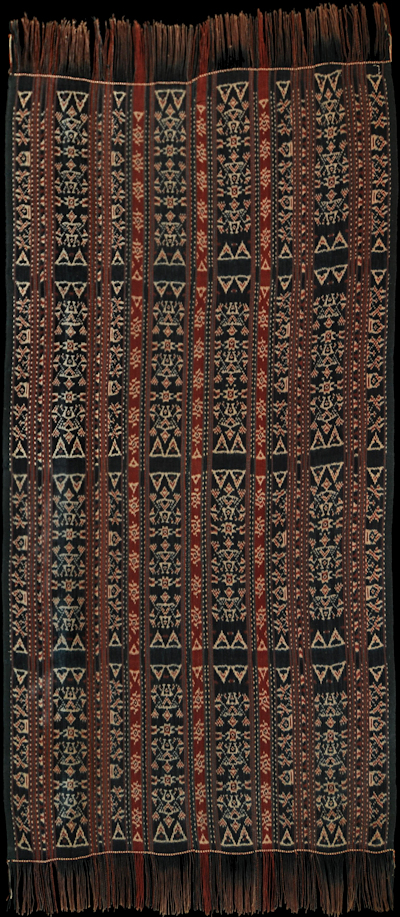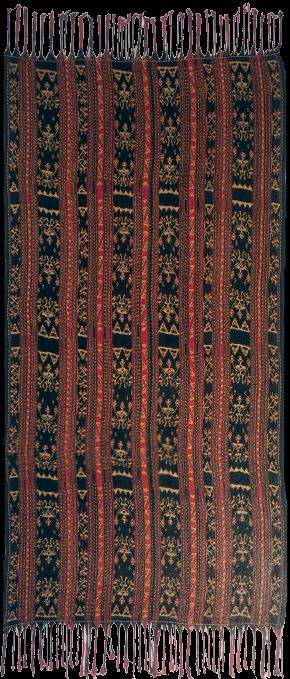| |
 
 | | | |
290 Roti Group, Ndao
Lafa (shawl)  
| | | Period: | 1900-1925 | | Yarn: | Cotton, hand-spun, medium | | Technique: | Warp ikat | | Panels: | 2 | | Size: | 85 x 169 cm (2' 9" x 5' 6") LW: 1.99 | | Weight: | 615 g (21.7 oz), 428 g/m2 (1.40 oz/ft2) | | Design: | Lafa for the nobles of Ndao Nuse, of a type called hua analangi. Numerous ikated bands and stripes in parallel, in the direction of the warp. The four widest show human figures with pinched waist and upraised hands, similar to that of Devi Sri motifs of Bali and Nusa Penida, but in a style very different form that of the human figures with upraised hands of Kisar, Luang and Romang. The hands show three fingers, as do most of the human figures on the South Moluccan islands. The sixteen blocks of anthropomorphic figures are all set off with rows of inward pointing triangles, like inverted tumpal finials. Asymmetric design: of the three morinda red stripes in the midfield, two are on one panel, one on the other. | | Comment: | Outstanding and very well preserved example of this classic type. Excellent, tight ikat and saturated colours make for clear drawing in sharp contrast. The asymmetric 'Savunese-style' field division is a Ndao hallmark. So is the deep burgundy red. The fine drawing and the high contrast make it very effective in dim lighting - which turns it into a starscape with scintillating constellations. Tightly twisted fringes. From old Dutch collection. | | Background: | Chapters on Roti Group and Ndao. | | Exhibited: | Hong Kong University Museum and Art Gallery, 2017. | | Published: | Ikat Textiles of the Indonesian Archipelago, 2018.
Ikat from Timor and its Outer Islands, 2022.
| | Compare: | 125 006 008 234 | | Sources: | Near-identical to pre-1938 Ndao lafa from the Helbig collection in Khan Majlis, Woven Messages, Fig. 237, and to a specimen in the Leiden Wereldmuseum, Leiden, Acc. nr. RV-B154-48. Very similar to circa 1920 lafa in the Krefeld Textile Museum, published in Völger and Von Welck, Indonesian Textiles, the supplement by Khan Majlis, Fig. 177, though somewhat smaller and with four rather than six main ikated bands. On the Savunese style field division as characteristic of Ndao versus Roti see Fox In Gittinger, Indonesian Textiles, p.48. Below the Helbig example:
 | | |

©Peter ten Hoopen, 2025
All rights reserved.
|
|


